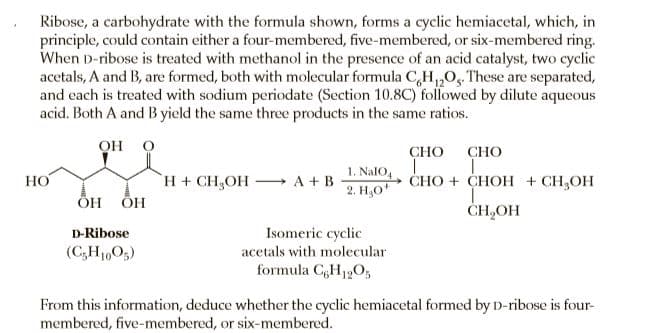Ribose, a carbohydrate with the formula shown, forms a cyclic hemiacetal, which, in principle, could contain either a four-membered, five-membered, or six-membered ring. When D-ribose is treated with methanol in the presence of an acid catalyst, two cyclic acetals, A and B, are formed, both with molecular formula C,H,0, These are separated, and each is treated with sodium periodate (Section 10.8C) followed by dilute aqueous acid. Both A and B yield the same three products in the same ratios. он о CHO СНО H+ CH,OH A +B ÕH 1. NalO, 2. H,0* НО CHO + CHOH + CH,OH ÕH CH,OH Isomeric cyclic acetals with molecular formula CH12O, D-Ribose (C;H1605) From this information, deduce whether the cyclic hemiacetal formed by D-ribose is four- membered, five-membered, or six-membered.
Ribose, a carbohydrate with the formula shown, forms a cyclic hemiacetal, which, in principle, could contain either a four-membered, five-membered, or six-membered ring. When D-ribose is treated with methanol in the presence of an acid catalyst, two cyclic acetals, A and B, are formed, both with molecular formula C,H,0, These are separated, and each is treated with sodium periodate (Section 10.8C) followed by dilute aqueous acid. Both A and B yield the same three products in the same ratios. он о CHO СНО H+ CH,OH A +B ÕH 1. NalO, 2. H,0* НО CHO + CHOH + CH,OH ÕH CH,OH Isomeric cyclic acetals with molecular formula CH12O, D-Ribose (C;H1605) From this information, deduce whether the cyclic hemiacetal formed by D-ribose is four- membered, five-membered, or six-membered.
Organic Chemistry
8th Edition
ISBN:9781305580350
Author:William H. Brown, Brent L. Iverson, Eric Anslyn, Christopher S. Foote
Publisher:William H. Brown, Brent L. Iverson, Eric Anslyn, Christopher S. Foote
Chapter16: Aldehydes And Ketones
Section: Chapter Questions
Problem 16.70P
Related questions
Question

Transcribed Image Text:Ribose, a carbohydrate with the formula shown, forms a cyclic hemiacetal, which, in
principle, could contain either a four-membered, five-membered, or six-membered ring.
When D-ribose is treated with methanol in the presence of an acid catalyst, two cyclic
acetals, A and B, are formed, both with molecular formula C,H,0, These are separated,
and each is treated with sodium periodate (Section 10.8C) followed by dilute aqueous
acid. Both A and B yield the same three products in the same ratios.
он о
CHO
СНО
H+ CH,OH A +B
ÕH
1. NalO,
2. H,0*
НО
CHO + CHOH + CH,OH
ÕH
CH,OH
Isomeric cyclic
acetals with molecular
formula CH12O,
D-Ribose
(C;H1605)
From this information, deduce whether the cyclic hemiacetal formed by D-ribose is four-
membered, five-membered, or six-membered.
Expert Solution
This question has been solved!
Explore an expertly crafted, step-by-step solution for a thorough understanding of key concepts.
This is a popular solution!
Trending now
This is a popular solution!
Step by step
Solved in 3 steps with 3 images

Recommended textbooks for you

Organic Chemistry
Chemistry
ISBN:
9781305580350
Author:
William H. Brown, Brent L. Iverson, Eric Anslyn, Christopher S. Foote
Publisher:
Cengage Learning


Organic Chemistry
Chemistry
ISBN:
9781305580350
Author:
William H. Brown, Brent L. Iverson, Eric Anslyn, Christopher S. Foote
Publisher:
Cengage Learning
